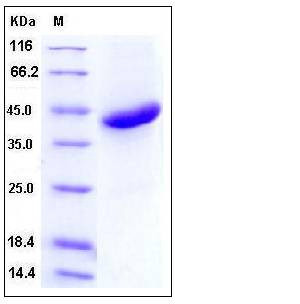Human R-Spondin 1 / RSPO1 Protein (His Tag)
CRISTIN3,R-Spondin 1,RSPO
- 100ug (NPP1591) Please inquiry
| Catalog Number | P11083-H08H |
|---|---|
| Organism Species | Human |
| Host | Human Cells |
| Synonyms | CRISTIN3,R-Spondin 1,RSPO |
| Molecular Weight | The secreted recombinant human RSPO1 comprises 254 amino acids with a predicted molecular mass of 28.2 kDa. As a result of glycosylation, rhRSPO1 migrates as an approximately 42 kDa band in SDS-PAGE under reducing conditions. |
| predicted N | Ser 21 |
| SDS-PAGE |  |
| Purity | > 98 % as determined by SDS-PAGE |
| Protein Construction | A DNA sequence encoding the human RSPO1 (NP_001033722.1) (Met 1-Ala 263) was expressed, fused with a polyhistidine tag at the C-terminus. |
| Bio-activity | 1. Measured by its binding ability in a functional ELISA. Immobilized human RSPO1 at 20 μg/ml (100 μl/well) can bind human LIMPII with a linear ranger of 32-800 ng/ml. 2. Measured by its binding ability in a functional ELISA. Immobilized human RSPO1 at 20 μg/ml (100 μl/well) can bind mouse CD36 with a linear ranger of 6.4-800 ng/ml. 3. Measured by its ability to induce activation of ßcatenin response in a Topflash Luciferase assay using HEK293T human embryonic kidney cells. The ED50 for this effect is typically 0.05-0.5 μg/mL in the presence of 5 ng/mL recombinant mouse Wnt3a. |
| Research Area | Signaling |Signal Transduction |Growth Factor & Receptor |R-Spondin Protein |
| Formulation | Lyophilized from sterile PBS, pH 7.4 1. Normally 5 % - 8 % trehalose, mannitol and 0.01% Tween80 are added as protectants before lyophilization. Specific concentrations are included in the hardcopy of COA. |
| Background | RSPO1 gene is a member of the R-spondin family. It encodes RSPO1 which is known as a secreted activator protein with two cystein-rich, furin-like domains and one thrombospondin type 1 domain. In mice, RSPO1 induces the rapid onset of crypt cell proliferation and increases intestinal epithelial healing, providing a protective effect against chemotherapy-induced adverse effects. This protein is an activator of the beta-catenin signaling cascade, leading to TCF-dependent gene activation. RSPO1 acts both in the canonical Wnt/beta-catenin-dependent pathway and in non-canonical Wnt signaling pathway, probably by acting as an inhibitor of ZNRF3, an important regulator of the Wnt signaling pathway. It also acts as a ligand for frizzled FZD8 and LRP6. |
| Reference |
